Timeline of modern American conservatism
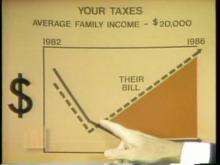
This timeline of modern American conservatism lists important events, developments and occurrences which have significantly affected conservatism in the United States. With the decline of the conservative wing of the Democratic Party after 1960, the movement is most closely associated with the Republican Party (GOP). Economic conservatives favor less government regulation, lower taxes and weaker labor unions, while social conservatives focus on moral issues and neoconservatives focus on democracy worldwide. Conservatives generally distrust the United Nations (UN) and Europe and, apart from the libertarian wing, favor a strong military and give enthusiastic support to Israel.[1]
Although conservatism has much older roots in American history, the modern movement began to gel in the mid–1930s when intellectuals and politicians collaborated with businessmen to oppose the liberalism of the New Deal, led by President Franklin D. Roosevelt (FDR), newly energized labor unions, and big city Democratic machines. After World War II that coalition gained strength from new philosophers and writers who developed an intellectual rationale for conservatism.[2]
Richard Nixon's victory in the 1968 presidential election is often considered a realigning election in American politics. From 1932 to 1968, the Democratic Party was obviously the majority party. During that time period, the Democrats had won seven out of nine presidential elections, and their agenda gravely affected that undertaken by the Republican Eisenhower administration. The election of 1968 reversed the situation completely. The Vietnam war split the Democratic Party. White ethnics in the North and white Southerners felt the national Democratic Party had deserted them. The white South has voted Republican at the presidential level since the mid-1960s, and at the state and local level since the 1990s.
In the 1980s President Ronald Reagan solidified conservative Republican strength with tax cuts, greatly increased defense spending, deregulation, a policy of rolling back communism (rather than just containing it), a greatly strengthened military, and appeals to family values and conservative Judeo-Christian morality. His impact has led historians to call the 1980s the "Reagan Era".[3] The Reagan model remains the conservative standard for social, economic and foreign policy issues. In recent years social issues such as abortion, gun control, and gay marriage have become important. Since 2009 the Tea Party Movement has energized conservatives at the local level against the policies made by the presidency of Barack Obama, leading to a Republican landslide in 2010 and again in 2014.
Chronology of events
1930s
As the nation plunges into its deepest depression ever, Republicans and conservatives fall into disfavor in 1930, 1932 and 1934, losing more and more of their seats. Liberals (mostly Democrats with a few Republicans and independents) come to power with the landslide 1932 election of liberal Democrat Franklin D. Roosevelt. In his first 100 days Roosevelt pushes through a series of dramatic economic programs known as the New Deal.[4]
The major metropolitan newspapers generally opposed the New Deal, as typified by William Randolph Hearst and his chain (Hearst had supported FDR in 1932 but parted ways in 1934.)[5] Robert R. McCormick, owner of the Chicago Tribune, compared the New Deal to communism. He was also an America First isolationist who strongly opposed entering World War II to rescue the British Empire. McCormick also railed against the League of Nations, the World Court, socialism and communism.[6]
- 1934
- Opposition to New Deal policies first takes shape as the American Liberty League. Led by conservative Democrats such as Al Smith, it fades after Roosevelt's 1936 landslide and disbands in 1940.[7][8] Businessmen begin organizing their opposition especially to labor unions.[9]
- 1935
- Former President Herbert Hoover develops his critique of New Deal liberalism based on the values of liberty, limited government, and constitutionalism.[10]
- 1936

- President Roosevelt calls his opponents "conservatives" as a term of abuse, they reply that they are "true liberals".[11]
- Most publishers favor Republican moderate Alf Landon for president. In the nation's 15 largest cities the newspapers that editorially endorsed Landon represented 70% of the circulation, while Roosevelt won 69% of the actual voters.[12]
- FDR carries 46 of the 48 states and liberals gain in both the House and the Senate, thanks to newly energized labor unions, city machines, and the WPA.[13] Since 1928 the GOP has lost 178 House seats, 40 Senate seats, and 19 governorships; it retains a mere 89 seats in the House and 16 in the Senate.[14]
- 1937
- Roosevelt's plan to pack the Supreme Court alienates conservative Democrats; most newspapers which supported FDR in 1936 oppose the plan, with many warning it was a prelude to dictatorship.[15]
- Conservative Republicans (nearly all from the North) and conservative Democrats (most from the South), form the Conservative Coalition and block most new liberal proposals until the 1960s.[16]
- The Conservative Manifesto (originally titled "An Address to the People of the United States") rallies the opposition to Roosevelt. It is drafted by Senators Josiah Bailey (D-NC) and Arthur H. Vandenberg (R-MI).[17]
- The liberal American Federation of Labor (AFL) and more leftist Congress of Industrial Organizations (CIO) labor federations are both growing and both support FDR. Their bitter feud over jurisdiction, however, produces numerous strikes, angers public opinion and weakens their political power.[18]
- 1938
- Opponents of conservatism weaken sharply. FDR's allies in the AFL and CIO battle each other; his court-packing plan is rejected; his attempt to purge the conservatives from the Democratic Party fails and strengthens them; the sharp recession of 1937–1938 discredits his argument that New Deal policies would lead to full recovery.[19]
- The Republicans make major gains in the House and Senate in the 1938 elections.[20]
- Leo Strauss (1899–1973), a refugee from Nazi Germany, teaches political philosophy at the New School for Social Research in New York (1938–49) and the University of Chicago (1949–1958). He was not an activist but his ideas have been influential.[21]
- 1939
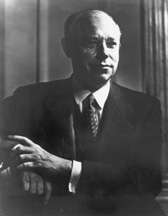
- As Republican senator from Ohio (1939–53), Robert A. Taft leads the conservative opposition to liberal policies (apart from public housing and aid to education, which he supported). Taft opposed most of the New Deal, entry into World War II, NATO, and sending troops to the Korean War. He was not so much an "isolationist" as a staunch opponent of the ever-expanding powers of the White House. The growth of this power, Taft feared, would lead to dictatorship or at least spoil American democracy, republicanism and civil virtue.[22]
1940s
- 1943
- Medical missionary Walter Judd (1898–1994) enters Congress (1943–63) and defines the conservative position on China as all-out support for the Nationalists under Chiang Kai-shek and opposition to the Communists under Mao. Judd redoubled his support after the Nationalists in 1949 fled to Formosa (Taiwan).[23]
- The American Enterprise Institute (AEI) is founded in Washington "to defend the principles and improve the institutions of American freedom and democratic capitalism—limited government, private enterprise, individual liberty and responsibility, vigilant and effective defense and foreign policies, political accountability, and open debate."[24]
- 1944

- March: Friedrich Hayek, an Austrian-born British economist, publishes The Road to Serfdom, which is widely read in America and Britain. He warns that well-intentioned government intervention in the economy is a slippery slope that will lead to tight government controls over people's lives, just as medieval serfdom had done.[25]
- The weekly magazine Human Events is founded by Frank Hanighen and Felix Morley with a significant contribution from ex-New Dealer Henry Regnery.[26][27] Ronald Reagan later says that the magazine "helped me stop being a liberal Democrat."[28]
- 1945
- Ludwig von Mises (1881–1973), having fled the Nazis, becomes professor of economics at New York University (1945–1969) where he disseminates Austrian School libertarianism.[29]
- 1946
- Milton Friedman (1912–2006) is appointed professor of economics at the University of Chicago.[30] Previously a Keynesian, Friedman moves right under the influence of his close friend George Stigler (1911–1991). He founds the market-oriented Chicago School of Economics which reshapes conservative economic theory. Stigler opposes regulation of industry as counterproductive; Friedman undermines Keynesian macroeconomics.[31] Friedman wins the Nobel Prize in 1976 and Stigler in 1982.
- November 5: Republicans score landslide victories in the House and Senate in off-year elections and set about enacting a conservative agenda in the 80th Congress.[32]
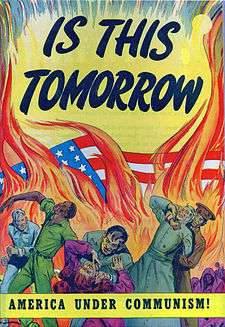
- 1947
- June 23: Congress passes the Taft-Hartley Act, designed by conservatives to create what they consider a proper balance between the rights of management and the rights of labor. Unions call it a slave labor law; Truman vetoes it and both houses override the veto.[33]
- 1948
- Deep South Democrats led by Strom Thurmond split from the National Democratic Party to form the pro-segregation States' Rights Democratic Party or Dixiecrat party. They are protesting support for civil rights legislation in the party platform and make Thurmond their nominee for president in the 1948 election. Nearly all return to the Democratic party in 1949.[34]
- Scholar Richard M. Weaver publishes Ideas Have Consequences, which influences intellectuals to question sophistic interpretations of literature.[35]
- June: Liberal Republican Thomas Dewey again wins the Republican nomination, to the frustration of conservatives.[36]
- November 2: Pundits are astonished when Dewey loses to incumbent Democrat Harry S. Truman in the presidential election.[37]
1950s
After the war, businessmen opposed to New Deal liberalism read Hayek, fight labor unions, and fund politicized think tanks such as American Enterprise Institute (founded 1943). They promote statewide right-to-work campaigns.[38]
- 1950
- The intellectual reputation of conservatism reaches a low ebb; Lionel Trilling observes that "liberalism is not only the dominant but even the sole intellectual tradition" and dismisses conservatism as a series of "irritable mental gestures which seek to resemble ideas."[39]
- February 9: Republican Senator Joseph McCarthy gives a speech saying, "While I cannot take the time to name all the men in the State Department who have been named as members of the Communist Party and members of a spy ring, I have here in my hand a list of 205." The speech marks the beginning of McCarthy's anti-communist pursuits.[40]
- 1951
- Political philosopher Francis Wilson in The Case for Conservatism (1951) defines conservatism as "a philosophy of social evolution, in which certain lasting values are defended within the framework of the tension of political conflict. And when given values are at stake the conservative can even become a revolutionary."[41][42]
- 1952
- In securing the Republican Party presidential nomination, Dwight D. "Ike" Eisenhower leads moderate and liberal Republicans to victory over Sen. Robert A. Taft, the conservative champion.[43] Ike then wins the presidency in a landslide by denouncing the failures of the Truman Administration in terms of "Korea, Communism and Corruption."[44]
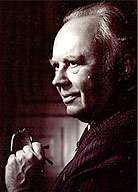
- Four major works of intellectual history that would influence conservatism are published: Daniel J. Boorstin's The Genius of American Politics, Peter Viereck's Conservatism: From John Adams to Churchill, Russell Kirk's The Conservative Mind, and Robert Nisbet's Quest for Community[45]
- Intercollegiate Studies Institute (ISI) is founded by libertarian journalist Frank Chodorov (1887–1966) to counter the growing spread of collectivism; its original name was Intercollegiate Society of Individualists.[46]
- 1953
- President Eisenhower works closely with Senator Taft, the new GOP majority leader, on domestic issues; they differ on foreign policy.[47]
- 1955
- The National Review weekly magazine is founded by William F. Buckley, Jr. (1925–2008). The editors include representative traditionalists, Catholics, libertarians and ex-communists. The most notable were Russell Kirk, James Burnham, Frank Meyer, Willmoore Kendall, L. Brent Bozell, Jr., and Whittaker Chambers.[48]
- In The Liberal Tradition in American, Louis Hartz claims that there has never been a European-style conservative tradition in America and that the sole mainstream tradition is Lockean liberalism.[49]
- 1957
- Russian-born philosopher Ayn Rand (1905–1982) publishes her novel Atlas Shrugged; it attracts the libertarian wing of American conservatism by promoting aggressive entrepreneurship and rejecting religion and altruism. She influences even those conservative intellectuals who reject her ethical system such as Buckley and Whittaker Chambers.[50][51]
- 1958
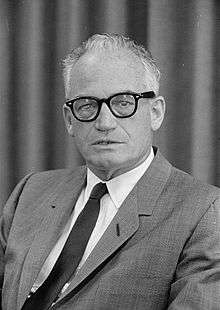
- Vermont C. Royster (1914–1996) becomes editor of the editorial page of The Wall Street Journal (1958 to 1971). He wins two Pulitzer Prizes for his conservative interpretation of economic and political news.[52]
- Conservatives try economic populism to appeal to blue collar workers forced to join labor unions. The GOP pushes "right-to-work" laws in California and elsewhere, but the unions counter-organize for the Democrats. Conservatives try again in 2011.[53][54]
- November 4: In a deep economic recession the Democrats score a landslide victory, defeating many old-guard conservative Republicans. The new Congress has large Democratic majorities: 282 Democrats to 154 GOP in the House, 64 to 34 in the Senate. Nevertheless, the new Congress fails to pass any major liberal legislation as most committee chairs are Southern Democrats who support the Conservative Coalition.[55] Two Republicans score upsets in the face of the landslide—liberal Nelson Rockefeller as Governor of New York,[56] and Barry Goldwater as Senator from Arizona;[57] both become presidential prospects.
- December 9: Businessman Robert W. Welch, Jr. (1899–1985) and twelve others found the John Birch Society, an anti-communist advocacy group with chapters across the country. Welch uses an elaborate control system that enables him to keep a very tight rein on each chapter. Its major activities are circulating petitions and supporting the local police. It becomes a favorite target of attack from the left and is disowned by many of the prominent conservatives of the day.[58]
- 1959
- As late as 1959 William Buckley complains that conservatives were "bound together for the most part by negative response to liberalism," and that, philosophically, "there [is] no commonly-acknowledged conservative position."[59]
1960s
Liberalism made major gains after the assassination of John F. Kennedy in 1963, as Lyndon B. Johnson (LBJ) pushed through his liberal Great Society as well as civil rights laws. An unexpected bonanza helped conservatism in the late 1960s as liberalism came under intense attack from the New Left, especially in academe. This new element, says liberal historian Michael Kazin, worked to "topple the corrupted liberal order."[60] For the New Left "liberal" became a nasty epithet. Liberal commentator E. J. Dionne finds that, "If liberal ideology began to crumble intellectually in the 1960s it did so in part because the New Left represented a highly articulate and able wrecking crew."[61]
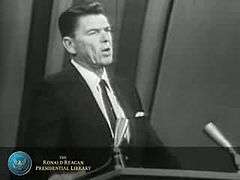 In support of Goldwater in 1964, Reagan delivers the TV address, "A Time for Choosing." The speech made Reagan the leader of movement conservatism | |
| Duration | 29:33 |
|---|---|
| Date | October 27, 1964 |
| Location | Los Angeles, CA, United States |
| Also known as | "The Speech" |
| Type | Televised campaign speech |
| Participants | Ronald Reagan |
| Website | Video clip, audio, transcript |
Movement conservatism emerges as grassroots activists react to liberal and New Left agendas. It develops a structure that supports Goldwater in 1964 and Ronald Reagan in 1976–80. By the late 1970s, local evangelical churches join the movement.[62][63] Liberalism faces a racial crisis nationwide. Within weeks of the passage of the 1964 Civil Rights law, "long hot summers" begin, lasting until 1970, with the worst outbreaks coming in the summer of 1967. Nearly 400 racial disorders in 298 cities saw blacks attacking shopkeepers and police, and looting stores.[64] Meanwhile, the urban crime rates shoot up. Demands for "law and order" escalate and the backlash causes disillusionment among working class whites with the liberalism of the Democratic Party.[65]
In the mid-1960s the GOP debates race and civil rights intensely. Republican liberals, led by Nelson Rockefeller, argue for a strong federal role because it was morally right and politically advantageous. Conservatives call for a more limited federal presence and discount the possibility of significant black voter support. Nixon avoids race issues in 1968.[66]

- 1960
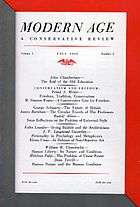
- Conservatives are angered when GOP presidential nominee Richard Nixon strikes a deal with liberal leader Nelson Rockefeller. Nixon agrees to put all 14 of Rockefeller's demands in the party platform, including promises that the executive branch be totally reorganized and that Rockefeller's liberal policies on economic growth, medical care for the aged and civil rights be included.[67] Led by Goldwater, conservatives vow to organize at the grass roots and take control of the GOP.[68]
- Barry Goldwater publishes The Conscience of a Conservative. The book helps the Arizona Senator reignite the conservative movement which rallies behind the charismatic Arizona Senator.[69]
- Fall: Frank S. Meyer's article, "Freedom, Tradition, Conservatism", is published in Modern Age, argues that traditional conservatism and libertarianism share a common philosophical heritage. The concept comes to be known as "fusionism" and unites the two strands of thought.[70]
- September: William F. Buckley, Jr., forms a youth group called the Young Americans for Freedom; it helps Goldwater win the 1964 nomination but is otherwise ineffective and collapses in internal bickering.[71]
- November 8: Nixon loses a close election to liberal Democrat John F. Kennedy.[72]
- 1961
- Christian Broadcasting Network (CBN) is founded by Pat Robertson; its signature program The 700 Club launches in 1966.[73]
- May 27: Texas elects Senator John Tower; he is the first Republican from the former Confederacy ever to win popular election and begins the growth of the GOP in that state.[74]
- 1962
- Buckley and the National Review launch denunciations of the John Birch Society; Goldwater agrees; the attack limits its influence to the conspiracy-minded.[75]
- 1963
- January 14: Governor of Alabama, Democrat George Wallace, electrifies the white South by proclaiming "segregation now, segregation tomorrow, segregation forever!" Wallace's angry populist rhetoric appeals to the poor farmers and workers who comprise a major part of the New Deal Coalition. He does well in Democratic primaries in the industrial North as well as the rural South. He exploits distrust of government, racial fear, anti-communism and a yearning for "traditional" American values.[77]

- 1964
- June 19: Senator Everett Dirksen (R-IL) plays a key role in passage of the 1964 Civil Rights Act to end segregation, but Goldwater joins Southern Democrats in voting against it.[79]

- July 4: George Wallace gives a speech condemning the Civil Rights Act of 1964, claiming that it would threaten individual liberty, free enterprise and private property rights and that "The liberal left-wingers have passed it. Now let them employ some pinknik social engineers in Washington, D.C., to figure out what to do with it."[80]
- July 13–16: Goldwater defeats liberal Republicans Rockefeller and Henry Cabot Lodge to win the GOP presidential nomination and launch a conservative crusade.
- July 13–16: Under attack as an "extremist," Goldwater lashes back in his speech accepting the GOP nomination:
I would remind you that extremism in the defense of liberty is no vice! And let me remind you also that moderation in the pursuit of justice is no virtue![81]
- November 3: In the presidential election, Goldwater is defeated in a landslide, and many GOP congressmen are defeated with him.[82]
- December: The American Conservative Union, the oldest conservative lobbying organization in the United States, is founded by William F. Buckley, Jr.[83]
- 1965
- William F. Buckley, Jr., gains national attention by running for mayor of New York City on the ticket of the new Conservative Party of New York State. He loses the election but gains visibility and respectability for the cause in the aftermath of Goldwater's defeat.[84]
- 1966
- April: Socialist Norman Thomas appears on the premiere episode of Firing Line with host William F. Buckley. The program remains on the air for 33 years and is the longest running television program with the same host.[85]
- November 8: Republicans score major gains in the off-year elections, emphasizing issues of law and order. Liberal candidates endorsed by the AFL–CIO do poorly.[86] Ronald Reagan is elected governor of California.[87]
- 1967
- New Left students hold highly publicized rallies chanting, "Hey– Hey– LBJ– How many kids did you kill today?" Their confrontational rhetoric and efforts to disrupt the draft alienates millions of voters, who move to the right.[88]
- A generational rift opens as leftist students espouse Marxism, sexual freedom, marijuana, rock music and long hair that outrages the older generation. Elite colleges and universities come under heavy pressure (but not the smaller state schools and community colleges that generally remain calm).[89]
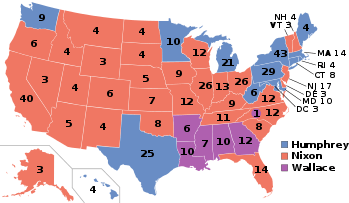
- The American Spectator monthly political magazine is founded by Emmett Tyrrell; its name until 1977 was The Alternative: An American Spectator.[90]
- Phyllis Schlafly launches the Eagle Trust Fund, a precursor to the conservative think tank Eagle Forum.[91]
- 1968
- Liberalism collapses politically as the Democratic Party splits into five factions over issues of Vietnam, race and attacks from New Left.[92] Richard Nixon is elected president over Hubert Humphrey and George Wallace (American Independent Party), emphasizing the need for law and order.[93] The New Left denounced Humphrey as a war criminal, Nixon attacked him as the New Left's enabler—a man with "a personal attitude of indulgence and permissiveness toward the lawless."[94] Beinart observes that "with the country divided against itself, contempt for Hubert Humphrey was the one thing on which left and right could agree."[95]
- 1969
- Libertarian economists, especially Milton Friedman and Walter Oi, lead the intellectual charge against the draft. Nixon abolishes it as the Vietnam War ends in 1973.[96]
- Young Americans for Freedom splits into competing, irreconcilable factions.[97] The libertarians, influenced by Ayn Rand, split from the traditionalists and form the Society for Individual Liberty.[98]
1970s
Historians Meg Jacobs and Julian Zelizer argue that the 1970s were characterized by "a vast shift toward social and political conservatism," as well as a sharp decline in the proportion of voters who identified with liberalism.[99] Neoconservatism emerges as liberals become disenchanted with Lyndon B. Johnson's Great Society welfare programs. They increasingly focus on foreign policy, especially anti-communism, and support for Israel and for democracy in the Third World.[100]
While Nixon continues to antagonize and anger liberals, many of his programs upset conservatives. His foreign policy with Henry Kissinger focuses on détente with the USSR and China, and becomes a main target of conservatives. Nixon is uninterested in tax cuts or deregulation, but he does use executive orders and presidential authority to impose price and wage controls, expand the welfare state, require Affirmative Action, grow the National Endowment for the Humanities and the National Endowment for the Arts, and create the Environmental Protection Agency (EPA).[101]
- 1970
- November 3: James L. Buckley is elected Senator for New York with 39% of the vote, running as a candidate for the Conservative Party of New York.[102]
- 1971
- Socialist Michael Harrington popularizes the term "neoconservative" for liberals who switch on foreign policy and domestic issues.[103][104]
- December 11: Libertarians meeting at the home of David Nolan organize the Libertarian Party which nominates John Hospers for president in 1972. John Hospers receives one electoral vote from a faithless elector.[105]
- 1972
- Richard Nixon wins a landslide reelection, carrying 49 states against anti-war liberal George McGovern. Suspicious of Democratic trickery, Nixon sends agents to bug the Democratic National Headquarters, then covers up his tracks when they are caught in the Watergate scandal.
- Phyllis Schlafly forms the "STOP (Stop Taking Our Privileges) ERA" movement; it blocks passage of the Equal Rights Amendment (ERA).[106]
- Robert L. Bartley (1937–2003) becomes editor of the editorial page of The Wall Street Journal; he retires in 2002 after writing and supervising tens of thousands of editorials taking a conservative position on economic and political issues. He is called "the most influential editorial writer" of his day.[107]
- 1973
- Traditional conservative Jesse Helms of North Carolina takes his Senate seat; he retires in 2002. As long-time chairman of the powerful Senate Foreign Relations Committee, he demands a staunchly anti-communist foreign policy that would reward America's friends abroad, and punish its enemies. His relations with the State Department are often acrimonious, and he blocks numerous presidential appointees. His National Congressional Club uses state-of-the-art direct mail operation to raise millions for conservative candidates and for Helms' own sharply contested reelections.[108]
- The American Conservative Union and Young Americans for Freedom start the Conservative Political Action Conference (CPAC) as a "small gathering of dedicated conservatives."[109]
- The Heritage Foundation is founded by Paul Weyrich, Edwin Feulner and Joseph Coors.[110]
- May: In response to the United States Supreme Court decision in Roe v. Wade, the National Right to Life Committee is formed, the oldest and largest pro-life organization in the United States.[111]
- 1974
- Robert Grant founds the American Christian Cause as an effort to institutionalize the Christian right as a politically active social movement.[112]
- January 22: The first March for Life attracts 20,000 supporters in Washington.[113]
- August 9: Conservatives, led by Goldwater, desert Nixon when the "smoking gun" is discovered that proves Nixon covered up the crimes of the Watergate scandal. Nixon resigns in disgrace, but his Secretary of State Henry Kissinger stays on in the moderately conservative administration of Gerald R. Ford.[114]
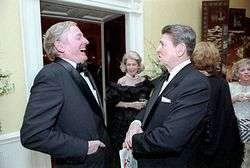
- November 4: Liberal Democrats attack Watergate and score major victories in the off-year elections.[115]
- 1976
- Commentary, a monthly Jewish magazine on politics, foreign policy, society and cultural issues that began as a liberal voice in the 1940s moves sharply to the right in the 1970s under editor Norman Podhoretz. It becomes an influential voice for Israel, anti-communism and neoconservatism by 1976, and supports Reagan in the 1980s.[116]
- George H. Nash publishes The Conservative Intellectual Movement in America Since 1945; he argues that Buckley's National Review fused together the traditional, libertarian and anti-Communist traditions to forge a conservative intellectual movement.[117]
- 1977
- Focus on the Family is founded by psychologist James Dobson.[118] The New York Times later calls Dobson "the nation's most influential evangelical leader."[119]
- The Save Our Children movement is formed by celebrity singer Anita Bryant to oppose the gay rights movement.[120]
- 1978
- Robert Grant, Paul Weyrich, Terry Dolan, Howard Phillips, and Richard Viguerie found Christian Voice, to recruit, train, and organize evangelical Christians to participate in elections. Grant later ousts the others.[121]
- June 6: California unleashes a tax revolt, with Proposition 13 to limit property taxes, promoted by Howard Jarvis (1903–1986), a long-time activist. The movement was backed by the United Organizations of Taxpayers, the Los Angeles Apartment Owners Association and realtors' associations.[122] Preconditions included steadily rising property taxes, "stagflation" and growing anger at government waste. California's tax revolt was followed by 30 other states.[123]
- 1979
- In reaction against liberal and presidential support for the UN's International Women's Year, conservative women meet in Houston to coordinate their grass roots work. Led by Phyllis Schlafly, they block passage of the ERA and work to nominate Ronald Reagan as the Republican candidate for president.[124]
- Beverly LaHaye and eight other women found Concerned Women for America (CWA) to oppose the Equal Rights Amendment. It later expands its scope to address socially conservative issues.[125] CWA has been described as "a key player in conservative evangelical politics" and according to CWA it is the largest women's organization in the United States.[126]
- February: Irving Kristol is featured on the cover of Esquire under the caption, "the godfather of the most powerful new political force in America – neoconservatism."[127]
- June: Jerry Falwell founds Moral Majority, marking the reentry of Fundamentalists into partisan politics.[128]
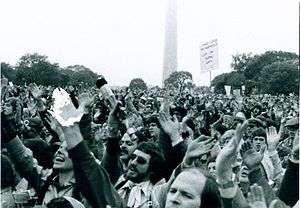

1980s
The decade is marked by the rise of the Christian right and the Reagan Revolution.[129] A priority of Reagan's administration is the rollback of Soviet communism in Latin America, Africa and worldwide.[130] Reagan bases his economic policy, dubbed "Reaganomics", on supply-side economics.[131]
- 1980
- April 29: Washington for Jesus marches in support of Reagan's positions on social issues as Pat Robertson brings together a theologically diverse coalition of charismatics, Pentecostals, Southern Baptists, and other evangelicals.[132]
- November 4: After denouncing Jimmy Carter's failed presidency, Reagan is elected president running on a "peace through strength" platform.[133] Republicans capture the Senate for the first time since 1953.[134]
- 1981
- Reagan promotes "supply side economics", arguing that tax cuts will stimulate the economy, which suffers high unemployment and high inflation (called "stagflation").[135]
- Reagan forms a coalition in Congress with conservative Democrats and passes his major tax cuts and increases in defense spending. He fails to cut welfare spending.[136]
- The Cold War heats up as Reagan pursues a rollback strategy in Latin America and Africa. He supports the anti-Communist "Contra" rebels who attempt to overthrow the pro-Communist Sandinista regime in Nicaragua.[137] Liberal Democrats in Congress try to block his moves and undercut the Contras, leading to a series of battles in the halls of Congress in which Reagan (mostly) prevails.[138] The Sandinistas are forced to hold fair elections in 1990, which they lose by 41%–55%.[139]
- 1982
- June 8: President Reagan tells the British Parliament that "the march of freedom and democracy will leave Marxism and Leninism on the ash heap of history"[140] and calls for a "crusade for freedom."[141]
- 1983
- March 8: President Reagan in a speech delivered to the National Association of Evangelicals denounces the Soviet Union (USSR) as an "Evil Empire".[142]
"Evil Empire"
Ronald Reagan delivers "Evil Empire" speech on March 8, 1983 |
- The International Democrat Union, also called the Conservative International, a transnational alliance of conservative and liberal conservative political parties, is founded in London. Officers of the Konrad Adenauer Foundation and Vice President George H. W. Bush are instrumental in the founding.[143]
- 1984
- November 6: proclaiming it's "Morning in America!" Reagan is reelected in a 49-state landslide victory over liberal Democrat Walter Mondale.[144]
- 1986
- September 17: Associate Justice William Rehnquist is confirmed as Chief Justice of the Supreme Court.[145] Reagan chooses Rehnquist in a deliberate effort to move the Court to the right, knowing he has the conservative constitutional agenda firmly in mind.[146]
- Replacing Rehnquist as Associate Justice, Antonin Scalia is confirmed by the Senate 90–0. He has been called "the creative, brilliant, and outspoken intellectual leader of the Court's conservative majority."[147]
- October 22: Congress enacts the Tax Reform Act of 1986, the second of the "Reagan Tax Cuts". The act simplifies the tax code, reduces the marginal income tax rate on the wealthiest Americans from 50% to 28%, and increases the marginal tax rate on the lowest-earning taxpayers from 10% to 15%.[148]
- November: the Iran Contra scandal draws national attention and threatened to derail Reagan's progress. Working with the CIA Reagan had authorized National Security Council officials to engage in a complicated sale of missiles to Iran with the goal of funding the Contras fighting Nicaragua. Blame increasingly centered on the key operative, Oliver North. However, in week-long dramatic testimony North emerges a conservative hero. North is convicted on minor counts but the conviction is reversed on appeal because he did not receive a fair trial. Reagan's reputation survives and he leaves office more popular than he began.[149]
- 1987
- June 12: In Berlin, President Reagan announces American terms for ending the Cold War, challenging Soviet leader Mikhail Gorbachev to "Tear down this wall!"; Gorbachev allows the Berlin Wall to come down in November 1989, ending Soviet control over Eastern European satellites.[150]
- August: The Federal Communications Commission abolishes the Fairness Doctrine. Talk radio becomes dominated by conservative hosts.[151]
- August 30: Pat Robertson (b. 1930), an Evangelical minister, founds the Christian Coalition, which becomes a prominent voice in the Christian right. Robertson also telecasts news and commentary on his own network, the Christian Broadcasting Network (CBN), founded in 1961. He runs poorly in the 1988 GOP presidential race and withdraws.[152]
- 1988
- August 1: The Rush Limbaugh Show debuts on Premiere Radio Networks and will become the highest-rated talk radio show in the United States.[153]
- November 8: George H. W. Bush is elected president.[154]
- 1989
- November: the Berlin Wall falls as the satellite states free themselves from Soviet control. West Germany absorbs East Germany in 1990, and in late 1991 Communism collapses in Russia as the red flag is lowered for the last time. Reagan becomes a hero in Eastern Europe.[155]
1990s

Conservative think tanks 1990–97 mobilize to challenge the legitimacy of global warming as a social problem. They challenge the scientific evidence, argue that global warming will have benefits, and warn that proposed solutions would do more harm than good.[156]
- 1991
- October 15: Clarence Thomas, a black Republican, is confirmed as an Associate Justice of the Supreme Court after controversial hearings that focus less on his strongly conservative beliefs than his relationship with one of his aides, Anita Hill, who accuses him of sexual harassment.[157]
- 1992
- November 3: George H. W. Bush is defeated by Bill Clinton in the presidential election. Bush had alienated much of his conservative base by breaking his 1988 campaign pledge: "Read my lips: no new taxes" He also seemed much more interested in remote foreign affairs than the domestic issues that concerned most voters.[158]
"Read my lips: no new taxes"
George H.W. Bush speaking about taxes at the 1988 Republican National Convention |
- 1994
- September 27: The Contract with America is released on the steps of the Capitol.[159] Designed by GOP House Whip Newt Gingrich, it had the effect of "nationalizing" the off-year election, as most Republican candidates endorsed it and used it as a template to promote a conservative agenda in economic policy. The Contract avoided divisive social issues.[160]
- November 8: in the Republican Revolution, Republicans take control of the House of Representatives for the first time in 40 years. The Democrats lose 52 seats in the House and 8 in the Senate, giving the GOP margins of 230 to 204 and 53 to 47.[161]
- 1995
- January 4: Newt Gingrich becomes Speaker of the House. His "Contract with America" scores mixed results in Congress. Its main points (and their fate in Congress) were:[162]
Legislation Result Welfare reform Passed Term limits for Congressmen Did not pass Balanced budget amendment Did not pass Increase rights of victims of crime Passed Pro-family tax credits Passed Decrease United States role in UN Did not pass Capital gains tax cut Passed Limit punitive damages on product liability Passed, but vetoed
- September: The Weekly Standard, founded by William Kristol, Fred Barnes and John Podhoretz, publishes its first issue.[163] It is known as "a redoubt of 'conservatism'".[164]
- 1996
- September: Congress passes and Clinton signs the Defense of Marriage Act. Senate Democrats try to repeal it in 2011.[165]
- October: Australian media mogul Rupert Murdoch launches Fox News Network. Its strong appeal to conservative viewers on cable television soon gives it more viewers than arch-rival Cable News Network (CNN).[166]
- 1997
- Matt Drudge launches his news website the Drudge Report.[167] His first assistant is Andrew Breitbart (1969–2012), who later becomes a prominent conservative voice on the web.[168] The Drudge Report achieves national prominence on January 17, 1998, when it publishes a story which comes to be known as the Monica Lewinsky scandal.[167]
- May: Joseph Farah launches news website WorldNetDaily.[169]
- 1998
- September 16: Christopher W. Ruddy starts conservative news website Newsmax.com. Its hourly updates provided timely ammunition to conservative talk show hosts.[170]
2000s
The terror attack on September 11, 2001 reorients the administration towards foreign policy and terrorism issues, providing an opportunity for neoconservatives to have a greater influence on foreign policy. The Bush Doctrine leads to long-term interventions in Afghanistan (2001 to present) and Iraq (2003–2011).[171]
On the domestic front Bush promises compassionate conservatism and works to improve education, address poverty nationwide, increase financial aid to poor countries and help alleviate AIDS in Africa.[172]
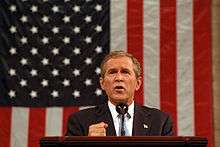
- 2000
- December 12: George W. Bush wins the 2000 presidential election after the Supreme Court halts a highly contentious recount in Florida.[173]
- 2001
- June 7: President Bush signed his 10-year tax cut into law; in 2000 he had promised to return the federal budget surplus through an across-the-board reduction in federal income taxes.[174]
- September 11: 9-11 terrorists attacks redefine the conservative role in foreign policy.[175]
- 2002
- Scott McConnell, Patrick Buchanan, and Taki Theodoracopulos found the paleoconservative magazine, The American Conservative.[176]
- 2003
- November 3: The Partial-Birth Abortion Ban Act is enacted.[177]
- 2004
- November 2: Conservatives mobilize to reelect President Bush; he defeats John F. Kerry.[178]
- 2005
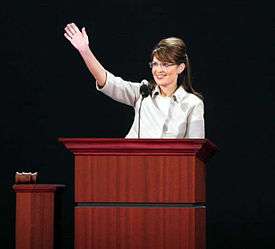
- Bush pushes for a private dimension to Social Security—allowing workers to invest a portion of their Social Security taxes in stocks and bonds—but it goes nowhere.[179]
- 2006
- January 31: Samuel Alito, nominated by George W. Bush, is confirmed as an Associate Justice of the United States Supreme Court on a party-line vote in the Senate.[180]
- November 7: Democrats make major gains in off-year elections, attacking the unpopular war in Iraq and the bungling of Hurricane Katrina relief.[181][182]
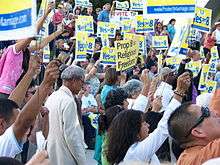
- 2007
- May 15: Christian right leader and founder of the Moral Majority, Jerry Falwell dies in his office in Lynchburg, Virginia.[183]
- Conservative talk show hosts mobilize fierce public opposition to the McCain-Kennedy immigration reform bill, which eventually fails.[184]
- 2008
- August 29: Little-known Alaska Governor Sarah Palin becomes the first woman on a national GOP ticket as nominee for Vice President.[185]
- November 5: Democrat Barack Obama defeated Republican John McCain by 53% to 46%. Barack Obama was elected and officially inaugurated as president of the United States of America on January 20, 2009. He was re-elected president in November 2012 and was sworn in for a second term on January 20, 2013. The national exit poll shows self-identified conservatives comprise 34% of the voters and support McCain 78% to 20%. Liberals comprise 22% of the voters and support Obama 89% to 10%. Moderates comprise 44% of the voters and support Obama 60% to 39%.[186]
- November 5: Proposition 8 which prescribes that marriage is between a man and a woman in California is passed with 52.2% of the vote.[187]
- 2009
- The Tea Party movement is founded, in part emerging from libertarian conservative Ron Paul's 2008 campaign for the Republican nomination.[188][189][190] The loosely organized conservative movement demands rigorous adherence to the Constitution, lower taxes, lower deficits, restrictions on illegal immigrants, and opposes Obama's health care proposals.[191]
- Activists Hannah Giles and James O'Keefe make sting videos compromising the integrity of Association of Community Organizations for Reform Now (ACORN); ACORN soon dissolves.[192]
2010s
Numerous historians after 1990 re-examined the role of conservatism in recent American history, according it much greater importance than before.[193] One school of thought rejects the older consensus that liberalism was the dominant ethos. Instead it argues conservatism dominated American politics since the 1920s, with the brief exceptions of the New Deal era (1933–36) and the Great Society (1963–66).[194] However Historian Julian Zelizer argues that "liberalism survived the rise of conservatism."[195]
- 2010
- Supreme Court decision in Citizens United v. FEC holds that the free speech clause of the First Amendment applies to political speech during elections, making spending limits unconstitutional in certain cases. The Court majority upheld the libertarian approach to free speech, while the dissenters took an egalitarian approach.[196]
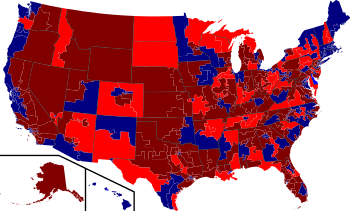
- November 3: in the largest GOP gain since 1938, 2010 became one of the most important elections in conservative history[197] as GOP candidates, fired up by Tea Party support, make major gains in midterm elections across the country for Congress, governorships and state legislatures. Conservative voters (self-identified) comprise 42% of the voters and support GOP House candidates 84% to 13%. Liberals comprise 20% of the voters and support Democrats 90% to 8%. Moderates comprise 38% of the voters and support the GOP 55% to 42%.[198] Republicans gain 63 seats in the House of Representatives and six seats in the U.S. Senate.
- 2012
- A central concern for conservatives in the 2012 GOP primaries was whether front-runner Mitt Romney is conservative enough. Numerous other challengers on the right rose and fell, notably Herman Cain, Rick Santorum, Newt Gingrich, Rick Perry, and Michele Bachmann.[199] Romney moved sharply to the right and chose deficit hawk Representative Paul Ryan of Wisconsin as his running mate.[200] Obama, however, successfully mobilized his base and won reelection, as Democrats made small gains in the House and Senate.
- 2014
- November 4: Conservatives in the GOP win majorities in both houses of congress, and flip several governorships in the 2014 midterm elections.
- 2016
- November 8: Conservatives continue to hold both houses of congress as well as take the White House. Donald Trump is elected as President of the United States, causing many to question the direction of conservatism in the United States' future.
See also
- Timelines
- Timeline of Black conservatism in the United States
- Timeline of libertarian thinkers
- Timeline of the Cold War
- Timeline of United States history
Notes
Footnotes
- ↑ Michael T. Thomas (2007). American policy toward Israel: the power and limits of beliefs. Routledge. pp. 42–43.
- ↑ Patrick Allitt (2009). The Conservatives: Ideas and Personalities Throughout American History. Yale University Press. ch 1–6 covers the story down to 1945.
- ↑ Sean Wilentz The Age of Reagan: A History, 1974–2008. (2009); John Ehrman The Eighties: America in the Age of Reagan. (2008) pp. 3–8.
- ↑ Anthony J. Badger (2009). FDR: the first hundred days. Hilland Wang. pp. 3–22, 74.
- ↑ Graham J. White (1979). FDR and the Press. University of Chicago Press. pp. 51–2. ISBN 9780226895123.
- ↑ Richard Norton Smith (2003). The Colonel: The Life and Legend of Robert R. McCormick, 1880–1955. Northwestern University Press. p. 349. ISBN 9780810120396.
- ↑ Frederick Rudolph, "The American Liberty League, 1934–1940," American Historical Review (1950) 56:1 pp. 19–33, in JSTOR
- ↑ George Wolfskill (1962). The Revolt of the Conservatives: A History of the American Liberty League, 1934–1940. Houghton Mifflin. p. 249.
- ↑ Kim Phillips-Fein (2010). Invisible Hands: The Businessmen's Crusade Against the New Deal. W. W. Norton. p. 15. ISBN 9780393337662.
- ↑ Gordon Lloyd and David Davenport, The New Deal and Modern American Conservatism: A Defining Rivalry (2013) excerpt and text search
- ↑ Brendon O'Connor (2004). A Political History of the American Welfare System: When Ideas Have Consequences. Rowman & Littlefield. p. 38. ISBN 9780742526686.
- ↑ Charles W. Smith Jr. (1939). Public Opinion in a Democracy. Prentice-Hall. pp. 85–86.
- ↑ Sternsher, Bernard (1984). "The New Deal Party System: A Reappraisal". Journal of Interdisciplinary History. 15 (1): 53–81. doi:10.2307/203594. JSTOR 203594.
- ↑ Michael Kazin, eta al, eds. (2011). The Concise Princeton Encyclopedia of American Political History. Princeton University Press. p. 203. ISBN 9780691152073.
- ↑ Jeff Shesol (2011). Supreme Power: Franklin Roosevelt Vs. The Supreme Court. W. W. Norton. pp. 299, 301–303. ISBN 9780393338812.
- ↑ Patterson, James T. (1966). "A Conservative Coalition Forms in Congress, 1933–1939". Journal of American History. 52 (4): 757–72. doi:10.2307/1894345. JSTOR 1894345.
- ↑ John Robert, Moore (1965). "Senator Josiah W. Bailey and the "Conservative Manifesto" of 1937". Journal of Southern History. 31 (1): 21–39. doi:10.2307/2205008. JSTOR 2205008.
- ↑ Walter Galenson (1960). The CIO challenge to the AFL. Harvard University Press. p. 542.
- ↑ William E. Leuchtenburg (1963). Franklin D. Roosevelt and the New Deal: 1932–1940. HarperCollins. pp. 231–74.
- ↑ Milton Plesur, "The Republican Congressional Comeback of 1938," Review of Politics, Oct 1962, Vol. 24 Issue 4, pp. 525–62 in JSTOR
- ↑ John P. East, "Leo Strauss and American Conservatism," Modern Age, (1977) 21:1 pp. 2–19 online
- ↑ Geoffrey Matthews, "Robert A. Taft, the Constitution and American Foreign Policy, 1939–53," Journal of Contemporary History, July 1982, Vol. 17 Issue 3, pp. 507–22
- ↑ Lee Edwards (1990). Missionary for Freedom: The Life and Times of Walter Judd. Paragon House. p. 210.
- ↑ Murray L. Weidenbaum (2009). The competition of ideas: the world of the Washington think tanks. Transaction Publishers. p. 23.
- ↑ F. A. Hayek (1944; 2nd ed. 2010). The Road to Serfdom. University of Chicago Press. 2nd ed. by Bruce Caldwell with prepublication reports on Hayek's manuscript, and forewords to earlier editions by John Chamberlain, Milton Friedman, and Hayek himself.
- ↑ Robert McG. Thomas, Jr. (June 23, 1996). "Henry Regnery, 84, Ground-Breaking Conservative Publisher". New York Times. Retrieved April 23, 2012.
- ↑ Richard V. Allen (June 2, 2008). "Turning the Tide". National Review Online. Retrieved April 23, 2012.
- ↑ Lee Edwards (February 5, 2011). "Reagan's Newspaper". Human Events. Retrieved April 23, 2012.
- ↑ Israel M. Kirzner (2001). Ludwig von Mises: the man and his economics. ISI Books. p. 25.
- ↑ He retired in 1977 and moved to the Hoover Institution at Stanford. Milton and Rose Friedman (1999). Two Lucky People: Memoirs. University of Chicago Press. p. 559.
- ↑ Alan O. Ebenstein (2009). Milton Friedman: A Biography Palgrave Macmillan. p. 259.
- ↑ Susan M. Hartmann (1971). Truman and the 80th Congress. University of Missouri Press. p. 7.
- ↑ James T. Patterson (1972). Mr. Republican: a biography of Robert A. Taft. Houghton Mifflin Company. pp. 352–68.
- ↑ Kari A. Frederickson (2000). The Dixiecrat Revolt and the End of the Solid South, 1932–1968. The University of North Carolina Press. passim.
- ↑ Fred D. Young (1995). Richard M. Weaver, 1910–1963: a life of the mind. University of Missouri. p. 9.
- ↑ Michael Bowen (2011). The Roots of Modern Conservatism: Dewey, Taft, and the Battle for the Soul of the Republican Party. The University of North Carolina Press. p. 66.
- ↑ "The Nation: Independence Day". Time. 1948-11-08. Retrieved 2010-05-26.
- ↑ Kim Phillips-Fein (2009). Invisible Hands: The Businessmen's Crusade Against the New Deal. W. W. Norton & Company. ch 2.
- ↑ Russell Kirk (2001). The Conservative Mind: From Burke to Eliot. Regnery. p. 476. ISBN 9780895261717.
- ↑ "'Communists in Government Service', McCarthy Says". United States Senate. Retrieved March 9, 2007.
- ↑ Charles W. Dunn; J. David Woodard (1991). American conservatism from Burke to Bush: an introduction. Madison Books. p. 29. ISBN 9780819180698.
- ↑ Francis Graham Wilson (2011). The Case for Conservatism. Transaction Publishers. p. 2. ISBN 9781412842341.
- ↑ James T. Patterson Mr. Republican: A Biography of Robert A. Taft. (1972). ch 32–35.
- ↑ William Lee Miller (2012). Two Americans: Truman, Eisenhower, and a Dangerous World. Random House Digital. p. 272. ISBN 9780307957542.
- ↑ Reba N. Sofer (2009). History, historians, and conservatism in Britain and the United States. Oxford University Press. p. 232.
- ↑ Lee Edwards (2003). Educating for Liberty: The first Half-century of the Intercollegiate Studies Institute Regnery. ch 1.
- ↑ Clarence E. Wunderlin (2005). Robert A. Taft: Ideas, Tradition, and Party in U.S. Foreign Policy. Rowman & Littlefield. p. 191. ISBN 9780742544901.
- ↑ John B. Judis (1990). William F. Buckley, Jr.: Patron Saint of the Conservatives. Simon & Schuster. pp. 121–4, 152.
- ↑ James T. Kloppenberg, "Review: In Retrospect: Louis Hartz's The Liberal Tradition in America," Reviews in American History Vol. 29, No. 3 (Sept 2001), pp. 460–478 in JSTOR
- ↑ Burns, Jennifer (2004). "Godless Capitalism: Ayn Rand and the Conservative Movement". Modern Intellectual History. 1 (3): 359–85. doi:10.1017/S1479244304000216.
- ↑ Jennifer Burns (2009). Goddess of the Market: Ayn Rand and the American Right. Oxford University Press. pp. 174–76.
- ↑ Richard J. Tofel (2009). Restless Genius: Barney Kilgore, The Wall Street Journal, and the Invention of Modern Journalism. Macmillan. p. 157. ISBN 9780312536749.
- ↑ Kim Phillips-Fein, "'As Great an Issue as Slavery or Abolition': Economic Populism, the Conservative Movement, and the Right-to-Work Campaigns of 1958," Journal of Policy History, (Oct 2011), 23:4 pp. 491–512 online
- ↑ Nelson Lichtenstein and Elizabeth Tandy Shermer, eds. (2012). The American Right and U.S. Labor: Politics, Ideology and Imagination. University of Pennsylvania Press. ch. 1.
- ↑ Congress and the Nation: 1945–1964 (1965). Congressional Quarterly. pp. 28–34.
- ↑ "People & Events: Nelson A. Rockefeller, 1908–1979". Public Broadcasting Service (PBS). Retrieved 20 April 2012.
- ↑ "Our Campaigns - AZ Senate Race, Nov 04, 1958". OurCampaigns.com. Retrieved 20 April 2012.
- ↑ Jonathan Schoenwald (2002). A Time for Choosing: The Rise of Modern American Conservatism. Oxford University Press. pp. 62–99.
- ↑ Hyrum S. Lewis (2007). Sacralizing the Right: William F. Buckley Jr., Whittaker Chambers, Will Herberg and the Transformation of Intellectual Conservatism, 1945–1964. ProQuest: PhD dissertation U. of Southern California. p. 8. ISBN 978-0-549-38999-6.
- ↑ Michael Kazin (1998). The populist persuasion: an American history. Cornell University Press. p. 197.
- ↑ E. J. Dionne (2004). Why Americans Hate Politics. Simon and Schuster. p. 37. ISBN 9780743265737.
- ↑ Rick Perlstein, "Thunder on the Right: The Roots of Conservative Victory in the 1960s," OAH Magazine of History, Oct 2006, Vol. 20 Issue 5, pp. 24–27
- ↑ James A. Hijiya, "The Conservative 1960s," Journal of American Studies, Aug 2003, Vol. 37 Issue 2, pp. 201–28
- ↑ Michael Omi and Howard Winant (1994). Racial formation in the United States: from the 1960s to the 1990s. Routledge. p. 196.
- ↑ Michael W. Flamm (2007). Law and Order: Street Crime, Civil Unrest, and the Crisis of Liberalism in the 1960s. Columbia University Press. ch. 9.
- ↑ Thurber, Timothy N. (2007). "Goldwaterism Triumphant? Race and the Republican Party, 1965–1968". Journal of the Historical Society. 7 (3): 349–84. doi:10.1111/j.1540-5923.2007.00221.x.
- ↑ Theodore H. White (1961). The Making of the President 1960. HarperCollins. pp. 197–99. ISBN 9780061900600.
- ↑ Laura Jane Gifford (2009). The Center Cannot Hold: The 1960 Presidential Election and the Rise of Modern Conservatism. Northern Illinois Univ Press. p. 17.
- ↑ Robert Alan Goldberg (1995). Barry Goldwater. Yale University Press. pp. 138–43, 179.
- ↑ John R. E. Bliese (2002). The Greening Of Conservative America. Westview Press. pp. 4–5.
- ↑ Gregory L. Schneider (1998). Cadres for Conservatism: Young Americans for Freedom and the Rise of the Contemporary Right. NYU Press. pp. 154, 167, 172.
- ↑ W. J. Rorabaugh (2002). Kennedy and the Promise of the Sixties. Cambridge U.P. p. 18. ISBN 9780521816175.
- ↑ David Marley (2007). Pat Robertson: an American life. Rowman & Littlefield Publishers. p. 97.
- ↑ Sean P. Cunningham (2010). Cowboy Conservatism: Texas and the Rise of the Modern Right. University Press of Kentucky. p. 53. ISBN 9780813125763.
- ↑ William F. Buckley, Jr., "Goldwater, the John Birch Society, and Me". Commentary (March 2008) online
- ↑ Kurson, Ken (November 5, 2011). "Book Review: Daisy Petals and Mushroom Clouds". The Wall Street Journal. Retrieved 24 April 2012.
- ↑ Dan T. Carter (2000). The politics of rage: George Wallace, the origins of the new conservatism, and the transformation of American politics LSU Press. p. 12.
- ↑ "'A Time for Choosing' (October 27, 1964)". Miller Center. Retrieved April 28, 2012.
- ↑ Robert D. Loevy (1997). The Civil Rights Act of 1964: the passage of the law that ended racial segregation. State University of New York Press. p. 359.
- ↑ Wallace, George C. (July 4, 1964). The Civil Rights Movement: Fraud, Sham, and Hoax (Speech). Retrieved April 26, 2012.
- ↑ William Safire (2008). Safire's Political Dictionary. Oxford U.P. p. 229. ISBN 9780195343342.
- ↑ Rick Perlstein (2004). Before the Storm: Barry Goldwater and the Unmaking of the American Consensus. Hill and Wang. ch. 22.
- ↑ "Our History". American Conservative Union. Retrieved 20 April 2012.
- ↑ Jonathan Schoenwald (2002). A Time for Choosing: The Rise of Modern American Conservatism. Oxford University Press. pp. 162–89.
- ↑ Laurence Zuckerman (December 18, 1999). "How 'Firing Line' Transformed the Battleground". The New York Times. Retrieved April 27, 2012.
- ↑ Draper, Alan (Winter 1989). "Labor and the 1966 Elections". Labor History. 30 (1): 76–92. doi:10.1080/00236568900890031.
- ↑ Matthew Dallek (2004). The Right Moment: Ronald Reagan's First Victory and the Decisive Turning Point in American Politics. Oxford University Press. p. ix.
- ↑ Steven M. Gillon (2008). The Pact: Bill Clinton, Newt Gingrich, and the Rivalry That Defined a Generation. Oxford U.P. pp. 20–22. ISBN 9780199886579.
- ↑ John T. Bethell (1998). Harvard observed: an illustrated history of the university in the twentieth century. Harvard U.P. pp. 218–32. ISBN 9780674377332.
- ↑ R. Emmett Tyrrell, Jr. ed. (1987). Orthodoxy: The American Spectator's 20th Anniversary Anthology. Harper & Row. ch. 1.
- ↑ Ford, Lynne E. (2010). Encyclopedia of Women and American Politics. Infobase Publishing. p. 158. ISBN 9781438110325. Retrieved February 23, 2015.
- ↑ Lewis L. Gould (1993). 1968: The Election That Changed America. Ivan R. Dee. pp. 7–30.
- ↑ Michael Flamm, "Politics and Pragmatism: The Nixon Administration and Crime Control," White House Studies, Feb 2006, 6:2 pp. 151–162
- ↑ Rick Perlstein (2008). Nixonland: The Rise of a President and the Fracturing of America. Simon and Schuster. p. 349. ISBN 9780743243025.
- ↑ Peter Beinart (2008). The Good Fight: Why Liberals – and Only Liberals – Can Win the War on Terror and Make America Great Again. HarperCollins. p. 49. ISBN 9780060841607.
- ↑ Bernard Rostker (2006). I want you!: the evolution of the All-Volunteer Force. RAND Corporation. pp. 66–70, 749.
- ↑ Kenneth J. Heineman (2001). Put your bodies upon the wheels: student revolt in the 1960s. Ivan R. Dee. p. 160.
- ↑ Jennifer Burns (2009). Goddess of the market: Ayn Rand and the American Right. Oxford University Press. p. 257. ISBN 9780195324877.
- ↑ Jacobs, Meg; Zelizer, Julian E. (2008). "Comment: Swinging Too Far to the Left". Journal of Contemporary History. 43 (4): 689–93. doi:10.1177/0022009408095423. JSTOR 40543230.
- ↑ Justin Vaïsse (2010). Neoconservatism: The Biography of a Movement Harvard University Press. passim.
- ↑ Joan Hoff (1995). Nixon Reconsidered. Basic Books. p. 118. ISBN 9780465051052.
- ↑ Timothy J. Sullivan (2009). New York State and the rise of modern conservatism: redrawing party lines. State University of New York Press. p. 135.
- ↑ Justin Vaïsse (2010). Neoconservatism: The Biography of a Movement. Harvard U.P. p. 298. ISBN 9780674050518.
- ↑ see his article
- ↑ Walker, Jesse (June 13, 2011). "John Hospers, RIP". Reason. Retrieved October 13, 2011.
- ↑ Donald T. Critchlow (2005). Phyllis Schlafly and Grassroots Conservatism: A Woman's Crusade. Princeton University Press. pp. 212–42.
- ↑ Robert D. Novak (January 13, 2003). "Who Is Robert Bartley?". Weekly Standard. Retrieved April 23, 2012.
- ↑ Link, William A. (2008). Righteous Warrior: Jesse Helms and the Rise of Modern Conservatism. St. Martin's Press. ISBN 9780312356002.
- ↑ John B. Judis (2001). William F. Buckley, Jr.: Patron Saint of the Conservatives. Simon & Schuster. pp. 356–7.
- ↑ Gregory L. Schneider (2009). The Conservative Century: From Reaction to Revolution. Rowman & Littlefield. p. 125. ISBN 9780742542853.
- ↑ Donald T. Critchlow (1995). The politics of abortion and birth control in historical perspective. Pennsylvania State University Press. p. 140.
- ↑ Glenn H. Utter and John Woodrow Storey (2001). The religious right: a reference handbook. Grey House Publishing. p. 88.
- ↑ "About Us". March For Life. 2012. Retrieved 2012-02-17.
- ↑ John W. Dean; Barry M. Goldwater, Jr. (2009). Pure Goldwater. Macmillan. pp. 296–98. ISBN 9780230611337.
- ↑ Michael Kazin; Rebecca Edwards; Adam Rothman, eds (2011). The Concise Princeton Encyclopedia of American Political History. Princeton U.P. p. 222. ISBN 9780691152073.
- ↑ Benjamin Balint (2010). Running Commentary: The Contentious Magazine That Transformed the Jewish Left Into the Neoconservative Right. PublicAffairs. passim.
- ↑ Jennifer Burns, "In Retrospect: George Nash's The Conservative Intellectual Movement in America Since 1945," Reviews in American History 32:3 (2004) pp. 447–62 online
- ↑ Dan Gilgoff (2008). The Jesus Machine: How James Dobson, Focus on the Family, and Evangelical America Are Winning the Culture War. Macmillan. p. 19. ISBN 9780312378448.
- ↑ James McEnteer (2006). Shooting the truth: the rise of American political documentaries. Praeger. p. 146.
- ↑ Roger Chapman, ed. (2010). Culture wars: an encyclopedia of issues, viewpoints, and voices. M. E. Sharpe. vol. 1, p. 55.
- ↑ Glenn H. Utter and John Storey, eds. (2001). The religious right: a reference handbook. ABC-Clio Inc. p. 123.
- ↑ Smith, D. A. (1999). "Howard Jarvis, Populist Entrepreneur: Reevaluating the Causes of Proposition 13". Social Science History. 23 (2): 173–210. JSTOR 1171520.
- ↑ Ballard C. Campbell, "Tax revolts and political change," Journal of Policy History, Jan 1998, Vol. 10 Issue 1, pp. 153–78
- ↑ Marjorie J. Spruill, "Gender and America's Right Turn," in Bruce J. Schulman and Julian E. Zelizer, eds. (2008). Rightward Bound: Making America Conservative in the 1970s Harvard University Press. pp. 71–89.
- ↑ Sarah Slavin (1995). U.S. Women's Interest Groups: Institutional Profiles. Greenwood Publishing Group. p. 138. ISBN 9780313250736.
- ↑ Aberbach, ed., Joel D. (2011). Crisis of Conservatism?: The Republican Party, the Conservative Movement, and American Politics After Bush. Oxford University Press. pp. Ch. 7. ISBN 9780199831364. Retrieved April 22, 2012.
- ↑ R. Emmett Tyrrell (2010). After the Hangover: The Conservatives' Road to Recovery. Thomas Nelson. p. 36.
- ↑ Susan Harding (2001). The book of Jerry Falwell: fundamentalist language and politics. Princeton University Press. p. 285.
- ↑ Michael Kazin; Rebecca Edwards; Adam Rothman, eds. (2009). The Princeton Encyclopedia of American Political History. Princeton U.P. p. 288. ISBN 9780691129716.
- ↑ Eric J. Schmertz eds.; et al. (1997). President Reagan and the World. Greenwood. p. 146. ISBN 9780313301155.
- ↑ Niskanen, William A.; Moore, Stephen (1996). "Supply-Side Tax Cuts and the Truth about the Reagan Economic Record". Cato Institute. p. 1. Retrieved April 21, 2002.
- ↑ Daniel K. Williams (2010). God's Own Party: the making of the Christian right. Oxford University Press. pp. 181–2.
- ↑ Skinner, Kiron K.; Kudelia, Serhiy; Bueno de Mesquita, Bruce; Rice, Condoleezza (September 15, 2007). "Politics Starts at the Water's Edge". The New York Times. Retrieved 20 April 2012.
- ↑ Kenneth F. Warren (2008). Encyclopedia of U.S. Campaigns, Elections, and Electoral Behavior. SAGE. p. 100. ISBN 9781412954891.
- ↑ Bruce S. Jansson (2011). The Reluctant Welfare State: Engaging History to Advance Social Work Practice in Contemporary Society. Cengage Learning. pp. 332–33. ISBN 9780840034403.
- ↑ Karl Gerard Brandt (2009). Ronald Reagan and the House Democrats: gridlock, partisanship, and the fiscal crisis. U. of Missouri Press. pp. 10–15. ISBN 9780826218353.
- ↑ Michael Kort (2001). The Columbia Guide to the Cold War. Columbia U.P. pp. 79–80. ISBN 9780231107730.
- ↑ Mary Beth Norton (2009). A People and a Nation: A History of the United States. Since 1865. Cengage. p. 862. ISBN 9780547175607.
- ↑ Tim Merrill (1994). "3". Nicaragua: a country study. Library of Congress.
- ↑ Pipes, Richard (June 3, 2002). "Ash Heap of History: President Reagan's Westminster Address 20 Years Later". Heritage Foundation. Retrieved 2007-02-13.
- ↑ Andrew Busch (2001). Ronald Reagan and the politics of freedom. Rowman & Littlefield. ISBN 9780742520530.
- ↑ James Mann (2010). The Rebellion of Ronald Reagan: A History of the End of the Cold War. Penguin. pp. 37–8. ISBN 9780143116790.
- ↑ Goldman, Ralph Morris (2002). The Future Catches Up: Transnational Parties and Democracy. London: Taylor & Francis. p. 418. ISBN 9780595228881.
- ↑ Gil Troy (2005). Morning in America: how Ronald Reagan invented the 1980s. Princeton University Press. pp. 147–74.
- ↑ Steven F. Hayward (2010). The Age of Reagan: The Conservative Counterrevolution: 1980–1989. Random House Digital, Inc. p. 417. ISBN 9781400053582.
- ↑ Mark V. Tushnet (2005). A Court Divided: The Rehnquist Court and the Future of Constitutional Law. W. W. Norton. p. 13. ISBN 9780393327571.
- ↑ Christopher E. Smith (1993). Justice Antonin Scalia and the Supreme Court's Conservative Moment. ABC-CLIO. p. 20. ISBN 9780275947057.
- ↑ Jeffrey H. Birnbaum; Alan S. Murray (1988). Showdown at Gucci Gulch: Lawmakers, Lobbyists, and the Unlikely Triumph of Tax Reform. Random House Digital, Inc. pp. 3–22. ISBN 9780394758114.
- ↑ William E. Pemberton (1998). Exit With Honor: The Life and Presidency of Ronald Reagan. M.E. Sharpe. pp. 172–90. ISBN 9780765600967.
- ↑ Romesh Ratnesar (2009). Tear down this wall: a city, a president, and the speech that ended the Cold War. Simon & Schuster. p. 6.
- ↑ Rusher, William (July 5, 2007). "Back to the Fairness Doctrine?". Townhall.com. Retrieved April 20, 2012.
- ↑ David Harrell Jr. (2010). Pat Robertson: A Life and Legacy. Wm. B. Eerdmans Publishing Company. passim.
- ↑ Joseph Turow (4th ed. 2011). Media Today. Routledge. p. 376.
- ↑ "1988: Bush wins with 'no new taxes' promise". BBC News Online: On This Date. November 9, 1988. Retrieved April 24, 2012.
- ↑ Charles W. Dunn (2009). The Enduring Reagan. University Press of Kentucky. p. 100. ISBN 9780813125527.
- ↑ Aaron M. McCright and Riley E. Dunlap, "Defeating Kyoto: The Conservative Movement's Impact on U.S. Climate Change Policy," Social Problems, Aug 2003, Vol. 50 Issue 3, pp. 348–73 in JSTOR
- ↑ Dan Thomas, Craig McCoy and Allan McBride, "Deconstructing the Political Spectacle: Sex, Race, and Subjectivity in Public Response to the Clarence Thomas/Anita Hill "Sexual Harassment" Hearings," American Journal of Political Science Vol. 37, No. 3 (Aug., 1993), pp. 699–720 in JSTOR
- ↑ Joel D. Aberbach and Gillian Peele (2011). Crisis of Conservatism?: The Republican Party, the Conservative Movement and American Politics After Bush. Oxford University Press. p. 31.
- ↑ Gary Donaldson (2007). Modern America: a documentary history of the nation since 1945. M.E. Sharpe. pp. 308–10 for original text. ISBN 9780765615374.
- ↑ Nicol C. Rae (1998). Conservative reformers: the Republican freshmen and the lessons of the 104th Congress. M.E. Sharpe. pp. 37–9. ISBN 9780765601292.
- ↑ James W. Ceaser; Andrew Busch (1997). Losing to win: the 1996 elections and American politics. Rowman & Littlefield. pp. 6–12. ISBN 9780847684069.
- ↑ Peter B. Levy (2002). Encyclopedia of the Clinton presidency. Greenwood. pp. 78–79. ISBN 9780313312946.
- ↑ "William Kristol". The Weekly Standard. Terry Eastland. Retrieved 24 April 2012.
- ↑ Boot, Max (December 30, 2002). "What the Heck Is a 'Neocon'?". The Wall Street Journal. Council on Foreign Relations. Retrieved 24 April 2012.
- ↑ Tom Cohen (November 10, 2011). "Senate panel passes repeal of Defense of Marriage Act". CNN Politics. Retrieved April 23, 2012.
- ↑ Stephen L. Vaughn, ed. (2009). Encyclopedia of American Journalism. Routledge. pp. 76, 177–78.
- 1 2 "Profile: Matt Drudge - Webmaster of pork pies". Scotsman.com. Johnston Publishing Ltd. March 1, 2008. Retrieved 24 April 2012.
- ↑ Sappell, Joel (August 4, 2007). "Hot links served up daily". Los Angeles Times. Tribune Company. Retrieved 2007-08-04.
- ↑ "About Us". World Net Daily. Joseph Farah. Retrieved May 25, 2011.
- ↑ Dick Morris and Eileen McGann (2006). Condi Vs. Hillary: The Next Great Presidential Race. HarperCollins. pp. 194–95. ISBN 9780060859848.
- ↑ Heiko Meiertöns (2010). The Doctrines of Us Security Policy: An Evaluation Under International Law. Cambridge University Press. pp. 182–87. ISBN 9780521766487.
- ↑ "Fact Sheet: Compassionate Conservatism" (Press release). The White House. April 30, 2002. Retrieved April 22, 2012.
- ↑ Richard A. Posner (2001). Breaking the Deadlock: The 2000 Election, the Constitution, and the Courts. Princeton University Press. passim.
- ↑ Wattenberg, Martin P. (2004). "Elections: Tax Cut Versus Lockbox: Did the Voters Grasp the Tradeoff in 2000?". Presidential Studies Quarterly. 34 (4): 838–48. doi:10.1111/j.1741-5705.2004.00227.x.
- ↑ Joel D. Aberbach and Gillian Peele (2011). Crisis of conservatism?: the Republican Party, the conservative movement and American politics after Bush. Oxford University Press. p. 205.
- ↑ Adam L. Fuller (2011). Taking the Fight to the Enemy: Neoconservatism and the Age of Ideology. Lexington Books. p. 264.
- ↑ Dorothy E. McBride (2008). Abortion in the United States: a reference handbook. ABC-CLIO. p. 185.
- ↑ John C. Green, Mark J. Rozell and Clyde Wilcox (2006). The Values Campaign?: The Christian Right and the 2004 Elections. Georgetown University Press. ch. 1.
- ↑ Alec Gallup; Frank Newport (2007). The Gallup Poll: Public Opinion 2005. Rowman & Littlefield. p. 130. ISBN 9780742552586.
- ↑ Babington, Charles (February 1, 2006). "Alito Is Sworn In On High Court: Senators Confirm Conservative Judge Largely on Party Lines". The Washington Post.
- ↑ David B. Magleby and Kelly D. Patterson, eds. (2008). The Battle for Congress: Iraq, Scandal, and Campaign Finance in the 2006 Election. Paradigm. ch. 1.
- ↑ Schier, Steven E. (2006). "Frustrated Ambitions: The George W. Bush Presidency and the 2006 Elections". Forum. 4 (3): 1–8. doi:10.2202/1540-8884.1142.
- ↑ "Rev. Jerry Falwell dies at age 73". CNN. 15 May 2007. Retrieved 6 November 2013.
- ↑ Currie, Duncan (2008-01-22). "Beyond the Border". The Weekly Standard.
- ↑ Daniel J. Balz; Haynes Johnson (2009). The Battle for America 2008: The Story of an Extraordinary Election. Penguin. p. 288. ISBN 9780670021116.
- ↑ See Exit Poll details
- ↑ Stanley D. Brunn, et al. eds. (2011). Atlas of the 2008 Elections. Rowman and Littlefield. p. 265.
- ↑ Mark Meckler; Jenny Beth Martin (2012). Tea Party Patriots: The Second American Revolution. Macmillan. p. 9. ISBN 9781429942690.
- ↑ Scott Rasmussen and Doug Schoen (2010). Mad As Hell: How the Tea Party Movement Is Fundamentally Remaking Our Two-Party System. Harper. ch. 1.
- ↑ Williams, Juan (May 10, 2011). "Juan Williams: The Surprising Rise of Rep. Ron Paul". Fox News.
- ↑ Theda Skocpol and Vanessa Williamson (2012). The Tea Party and the Remaking of Republican Conservatism. Oxford University Press. pp. 45–82.
- ↑ Scott Rasmussen; Doug Schoen (2010). Mad As Hell: How the Tea Party Movement Is Fundamentally Remaking Our Two-Party System. HarperCollins. p. 228. ISBN 9780062016720.
- ↑ Phillips-Fein, Kim (2011). "Conservatism: A State of the Field". Journal of American History. 98 (3): 723–43. doi:10.1093/jahist/jar430., with commentary by Wilfred M. McClay, Alan Brinkley, Donald T. Critchlow, Martin Durham, Matthew D. Lassiter, and Lisa McGirr, and response by Phillips-Fein, pp .744–73 online
- ↑ Labor historians Jefferson Cowie, and Nick Salvatore, "The Long Exception: Rethinking the Place of the New Deal in American History," International Labor & Working-Class History, (2008) 74:3–32, argue the New Deal was a short-term response to depression and did not mark a permanent commitment to a welfare state because America has always been too individualistic and too hostile to labor unions
- ↑ Zelizer, Julian E. (2010). "Reflections: Rethinking the History of American Conservatism". Reviews in American History. 38 (2): 367–92, quote p. 380. doi:10.1353/rah.0.0217.
- ↑ Yasmin Dawood, "Campaign Finance and American Democracy." Annual Review of Political Science (2015) Abstract & download
- ↑ Theda Skocpol and Vanessa Williamson (2011). The Tea Party and the Remaking of Republican Conservatism. Oxford University Press. pp. 138, 149.
- ↑ "Election Center". CNN. Turner Broadcasting System. Retrieved 24 April 2012.
- ↑ James Hohmann (2012-02-12). "Romney doubles down, wins CPAC, Maine caucuses". POLITICO. Retrieved 2012-05-04.
- ↑ Murray, Sarah; Nelson, Colleen McCain; O'Connor, Patrick (August 12, 2012). "Romney Picks Ryan as Vice-Presidential Running Mate". The Wall Street Journal. Retrieved 2012-08-15.
Bibliography
- Allitt, Patrick. The Conservatives: Ideas and Personalities Throughout American History (2009)
- Carlisle, Rodney P. (2005). Encyclopedia of Politics: The Left and the Right. Sage Publications.
- Congressional Quarterly. Congress and the Nation: 1945–1964 (1965); Congress and the Nation: 1965–1968 (1969); with new volumes every four years, 1973, 1977... etc. Highly detailed nonpartisan timelines of political activity in Washington.
- Crane, Michael (2004). The Political Junkie Handbook. SP Books. ISBN 9781561718917. elaborate details on hundreds of political groups and media across the spectrum
- Critchlow, Donald T. The Conservative Ascendancy: How the Right Made Political History (2nd ed. 2011)
- Cunningham, Sean P. Cowboy Conservatism: Texas and the Rise of the Modern Right (2010).
- Filler, Louis. Dictionary of American Conservatism (Philosophical Library, 1987)
- Frohnen, Bruce et al. eds. American Conservatism: An Encyclopedia (2006); the most detailed reference
- Hamowy, Ronald, ed. (2008). "The Encyclopedia of Libertarianism". The Encyclopedia of Libertarianism. Thousand Oaks, CA: SAGE Publications, Cato Institute. ISBN 978-1-4129-6580-4. LCCN 2008009151. OCLC 750831024.
- Nash, George H. The Conservative Intellectual Movement in America Since 1945 (1976)
- Sandbrook, Dominic. Mad as Hell: The Crisis of the 1970s and the Rise of the Populist Right (Anchor, 2012) 544pp; popular history
- Schneider, Gregory. The Conservative Century: From Reaction to Revolution (2009)
- Story, Ronald; Bruce Laurie (2007). Rise of Conservatism in America, 1945–2000: A Brief History with Documents. Bedford/St. Martin's.
- Videos
- Allitt, Patrick N. (2009). The Conservative Tradition (CD). The Teaching Co. ISBN 978-1-59803-548-3.

.svg.png)